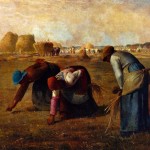Jeffrey Overstreet, who’s writing a book about his experiences as a film critic in/to Evangelical America, has posed the question, “What would you show in a film festival about ‘Calls to Conscience and Action’?” Specifically, he’s looking for “works of art that make us want to put our hands to the plow.”
Frankly, his question makes me uncomfortable. I say that, in part, because I’m having trouble coming up with one or two specific titles (a topic I’ll come back to later) but mostly because it’s been so long since my hand last touched a plow, metaphorical or otherwise. I’m more the “righteous indignation” type — the guy who carefully positions himself above the fray while the “Red States,” on the one side, react against liberal America’s progressive agendas, and the “Hollywood Elite,” on the other, try to decide which is the bigger evil: racism, homophobia, or, um, Joe McCarthy. I prefer to strike the pose of the humanist aesthete, sniping soldiers on both sides from the satisfied comfort of my expensive home theater. It’s so much easier than, you know, doing something. (Have you ever tried to plow? That shit is hard.)
Sarcasm aside, I’ll admit to feeling a bit shamed by Jeffrey’s question. That it would arise from a book project addressed to Evangelical readers should come as little surprise. Whatever frustrations I feel toward that world’s cultural and ideological assumptions are always tempered by my genuine love and respect for so many people who have found their spiritual home there. Color me ambivalent. When, a few years ago, I suggested to some friends that we temporarily set aside our Bibles and study art instead, I first had to convince them that the questions we’d been trained to ask would remain essentially unchanged: What does this text (whether Scripture, a painting, or a film) teach us about truth, beauty, and grace? What aspects of God’s character are revealed here? And how do we apply these lessons to our daily lives? Say what you will about Evangelical America’s failure to meet Christ’s standards (and I’ve said more than my share), but that question of application — of putting hand to plow — is more prominent there than in any other American sub-culture I’ve inhabited.
And so it pains me to review my life as a critic (for lack of a better word) and find so little evidence of my faith/politics/aesthetics translated into practical action. Maybe this hypocrisy (too strong?) is partly to blame for the ferocity of the public debate surrounding the Oscars this year. High-minded talk, whether from the Right or the Left, divorced from sympathy and service will inevitably come off as smug.
I’m deliberately overstating the case here. Of course my sense of the world, of right action, of human tragedy and grace have been radically transformed by an immersion in the arts. At the heart of the matter, I think, is the simple idea of empathy. (Slacktivist, by the way, has written two great posts on the subject this week.) I wonder, for example, how I would view the war in Iraq if, instead of watching regional, humanist filmmakers like Kiarostami, Makhmalbaf, and Majidi, I was learning about righteous vengeance, sadism, and “freedom” from Hollywood. The creative imagination, as expressed through great art, can be an empathy-making wonder. Christ, after all, was a prophet and a storyteller.
But to answer Jeffrey’s question: If offered the chance to program a “Calls to Conscience and Action” festival, my opening night film would be The Gleaners and I (2000), Agnes Varda’s documentary about the long-standing tradition of gathering up leftover crops (“gleaning”) after the fields have been harvested. Varda, as much an essayist as filmmaker, explores gleaning as a hypertext of ideas: gleaning is an alternate economy; at times it’s a moral choice, at others a lamentable necessity; it’s both transgressive and communal; and, finally, it’s a metaphor for the artistic process itself. As Jonathon Rosenbaum points out, Varda expresses the ambiguities of gleaning even in the title of the film, though her point is lost in translation:
There’s a suggestive discrepancy between the French and English titles of this wonderful essay film completed by Agnes Varda last year. It’s a distinction that tells us something about the French sense of community and the Anglo-American sense of individuality — concepts that are virtually built into the two languages. Les glaneurs et la glaneuse can be roughly translated as “the gleaners and the female gleaner,” with the plural noun masculine only in the sense that all French nouns are either masculine or feminine. The Gleaners and I sets up an implicit opposition between “people who glean” and the filmmaker, whereas Les glaneurs et la glaneuse links them, asserting that she’s one of them.
Regardless of what would follow on the festival program, The Gleaners and I would properly frame the central question of conscience and action, making it a matter of community (or, to satisfy the pomo Christians in the audience, we could call it “kingdom” instead) and foregrounding art as an underutilized means of consciousness-raising, community-building, and (dare I say it) worship.
I would also program The Gleaners and I for personal reasons. For a large number of viewers, the most memorable sequences in the film involve a young man who, despite having earned a Masters degree in Biology, has chosen to glean his food from a Paris market and to live in a shelter, side-by-side with the newly-arrived immigrants to whom he voluntarily teaches French most nights of the week. I can’t imagine that I would have become an English as a Second Language teacher myself had I not first met so many non-Americans through the literatures and cinema of their countries. My ESL work is as close as I’ve come, I suppose, to pushing a plow, though that metaphor distorts the actual experience. It implies calloused hands, sweat, and sacrifice.
